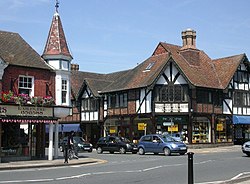Haslemere
| Haslemere | |
| Surrey | |
|---|---|
 High Street, Haslemere | |
| Location | |
| Grid reference: | SU898329 |
| Location: | 51°5’24"N, 0°42’42"W |
| Data | |
| Population: | 15,612 (2001) |
| Post town: | Haslemere |
| Postcode: | GU27 |
| Dialling code: | 01428 |
| Local Government | |
| Council: | Waverley |
| Parliamentary constituency: |
South West Surrey |
Haslemere is a town tucked in the south-western corner of Surrey, close by the borders with Hampshire and Sussex. It stands on the Portsmouth Road, the major route between London and Portsmouth, the main route now assumed the A3 which lies to the west. The south branch of the River Wey runs to the south. Haslemere is approximately 12 miles southwest of Guildford.
Haslemere is surrounded by hills. Blackdown across in Sussex (that county's highest point rises to the south and Gibbet Hill is to the north. The latter was the site of executions in past centuries. Many of those hanged there were highwaymen, because the roads around Haslemere, particularly alongside the nearby Devil's Punch Bowl, were notoriously dangerous.
Today, much of the heathland and woodland is owned and protected by the National Trust, and has become a popular attraction for walkers.
The town also marks the western end of the Greensand Way footpath which extends for 110 miles to Hamstreet in Kent, and is one end of the "Serpent Trail".
History
The earliest record of Haslemere was in 1221 as a Godalming tithing. The name describes hazel trees standing beside a mere. The lake does not exist today, but there is a natural spring in West Street which could have provided its source. In the 14th century, Haste Hill, also called East Hill, was the main settlement at Haslemere and there may have been a church as there were references on the site to "Churchliten field" and the "Old church-yard" of Haslemere.
Haslemere was granted a charter by Richard II in 1394. This right was confirmed by a new charter issued by Elizabeth I in 1596. Today, this special status is celebrated with the Charter fair, held once every two years in the High Street. There is a bust of Elizabeth I in the newly developed Charter Walk, linking West Street with the car park alongside the supermarket.
The town was one of the "rotten boroughs".
The town's fortunes rose with the construction of the Portsmouth Direct Line, which connected Haslemere with London Waterloo and Portsmouth Harbour railway stations. The town became a smart place to live and continues to be a popular commuter town, still served by Haslemere railway station.
St Bartholomew's Church was originally a chapel of ease for Chiddingfold, and probably dates from no earlier than the 16th century. It was rebuilt in 1871. The bell tower is the only remaining part of the original building. The church contains memorials to many of the most prominent local residents, including Alfred Lord Tennyson, who lived south of Haslemere at Aldworth House and is commemorated in one of the stained glass windows, featuring Sir Galahad and the Holy Grail.
Haslemere museum is at the northern end of the High Street. It was established by eminent surgeon Sir Jonathan Hutchinson in 1888 to provide educational opportunities to local people, and moved to its present location in 1926 – a house with a Georgian era|Georgian façade, but partly dating back to the 16th century. The museum has a permanent natural history collection as well as hosting talks from both local and national figures of interest.
Haslemere Charter Fair
In 1397 Richard II and the Bishop of Salisbury confirmed an order dated the 29th April 1221 allowing an annual fair to be held in the town. The first ever recorded fair was held in the year 1394 and the latest to date was held 7 May 2012. It ceased to be a yearly event some time ago, but was reinstated in 1984 and now runs every two years.
Today
The High Street is wide because of its use as a Victorian cattle market, and is at the heart of Haslemere, with the Town Hall standing at its southern end. There are two public houses: The White Horse and The Swan Inn. Along the High Street, West Street and Charter Walk are a mix of shops (mostly independent), restaurants, cafés, banks and estate agents.
Haslemere has a concert hall known as Haslemere Hall. Located on Bridge Road, just off West Street, the hall can seat 340 people and is used regularly as a theatre, a concert venue and as a cinema. Performances are held by local theatre groups including The Haslemere Thespians, The Haslemere Theatrical Society and the Haslemere Players. Haslemere Symphony Orchestra and Chorus also hold performances and there are popular music concerts. Films are shown shortly after their general release.
To the west of the High Street, separated from it by the railway station is an area known as Wey Hill. Here, there are further banks, public houses, shops (again, mostly independent), restaurants and takeaways. The town library is in Wey Hill and so are three supermarkets.
References
Outside links
| ("Wikimedia Commons" has material about Haslemere) |